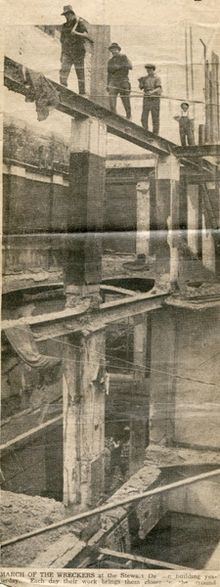 | ||
Whelan the wrecker house demolition
Whelan the Wrecker was a family owned and operated Australian demolition company which began in Brunswick, Victoria and was later based in Melbourne. The company became well known through the 1960s and 1980s for its role in the destruction of a number of grand Victorian era buildings of Marvellous Melbourne that the city had become famous for, many of them along Collins Street's "golden mile", which has led to much criticism, particularly in recent times.
Contents
A history of change
As the thousands of soldiers arrived back from the battlefields following the end of World War I there emerged a sense of renewed pride and a willingness to forget the dark days of war. The Council of the City of Melbourne was no doubt buoyed by this new nationalistic pride and put in place schemes to modernize the city which included increasing the building height limit and removing some of the Victorian era cast ironwork.
In the years leading up to World War II the Whelan firm had already pulled down thousands of structures in both the city and surrounding suburbs. James Paul Whelan's obituary of 1938 suggests that his company had the task of demolishing up to 98% of buildings marked for removal in the city alone.
From the 1950s onwards society, and the economy, had entered a state of change so vast that the ‘Whelan the Wrecker Is Here’ sign became a powerful symbol of the desire for urban renewal and social change in Victoria, Australia. Many simply labelled this period as "progress" while others mourned the loss of the aesthetic architecture which gave the city its character.
Prior to the 1956 Summer Olympics Wreckers, such as Whelan's, were primarily responsible for executing a City of Melbourne by-law, which in 1954 called for the demolition of all cast-iron verandas, supposedly aimed at removing the risk of pedestrians accidentally colliding with a pole. The act in fact resulted in the demolition of many of Melbourne's much-loved buildings well before heritage legislation took effect in the late 1980s, and the city which could claim more decorative cast iron than any city in the world had suddenly found cast iron in the Central Business District to be extremely rare.
Of the few demolition companies in Melbourne during the era of the 1960s to 1980s, when many of Melbourne's Victorian era buildings were demolished, Whelan the Wrecker was the biggest and won the most contracts. The threat of destruction, of what some saw as part of the national heritage, inspired the formation of the National Trust of Victoria.
Family business
The company itself is a family business which has operated since the early 1890s when James Paul Whelan began business in Brunswick, Victoria. When James died in 1938 his funeral was attended by a number of Melbourne identities including members of Parliament, the Master Builders Association and Melbourne City Council. and in 1939 control passed to his three sons. The company went into liquidation and ceased operations in 1992. The Whelan family were high profile members of the Catholic community and were credited as being both a, "generous and practical benefactor of the Christian Brothers".
Despite the company's unpopular reputation, unlike many of the planners and businesses of various eras whose agenda was achieved by the demolitions, the owners have always expressed an appreciation for heritage. This is evidenced in a biography, A City Lost & Found: Whelan the Wrecker's Melbourne, by Robyn Annear, published in 2006, which claims that many of the parts from the buildings were actually salvaged and preserved by the wreckers.
Some well known Melbourne buildings which were demolished by Whelan the Wrecker include;
Some of the company's more unusual demolition jobs included;
During the late 1980s the business expanded to include its own rubbish removal company designated Whelan Kartaway Pty Ltd, formed when it took over the Kartaway skip company.
